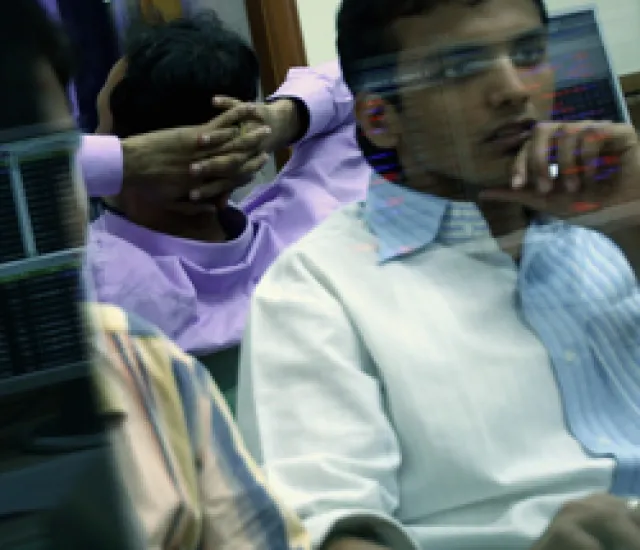Many economists predict that India’s real gross domestic product growth will slow this year and next to only about 7.5 percent per annum — a disappointment in relative terms, as recession-battered developed markets would welcome such a rate. But India’s promise as an investment destination remains largely unfulfilled, its growth constrained by a government viewed as unresponsive, ineffectual and riddled with corruption. View the full ranking here.
The Reserve Bank of India raised interest rates a record ten times from March 2010 through June 2011 in an effort to curb inflation, which reached an estimated 8.6 percent in the financial year that ended in March — fully half a percentage point above consensus estimates of 8.1 percent. But in June the government granted permission for state-run refiners to raise diesel and cooking gas prices, a move that is intended to reduce the country’s budget deficit but that also will likely fuel inflation.
Add to this inflation battle such high-profile scandals as the one that’s roiling India’s telecommunications industry, in which the country’s Central Bureau of Investigation accused government officials of awarding contracts to politically connected companies at prices far below their actual value. The alleged fraud, which India’s Comptroller and Auditor General estimates may have cost the government an estimated $40 billion in lost revenue, forced the resignation late last year of a top government minister, Andimuthu Raja (who has been charged with conspiracy, criminal misconduct and abusing an official position), and tainted the government of Prime Minister Manmohan Singh, who promised to fight corruption. Raja has denied any wrongdoing.
“The scams have scared people who did not have any investments in India,” observes N. Krishnan, head of Indian equity research for CLSA Asia-Pacific Markets. “Even for those investors with a history of being in India, corruption has become fairly high in their consciousness.”
Sanjeev Prasad, executive director and co-head of institutional equities at Kotak Securities, agrees. “Foreign investors are concerned about the bad macro picture and the lack of governance,” he says. “Until you see a resolution of these issues, India will not be a favored destination for global funds.”
Perhaps not, but many investors are willing to take their chances now — with the help of insightful research that alerts them to moneymaking opportunities and steers them away from potential trouble spots. The clear favorite at providing that research is CLSA Asia-Pacific Markets, according to portfolio managers and buy-side analysts who participated in Institutional Investor’s inaugural All-India Research Team survey. CLSA captures 15 total team positions, half again as many as the two firms that tie for second place: Credit Suisse and Kotak Securities. BofA Merrill Lynch Global Research comes in a close fourth, with nine positions, followed by Morgan Stanley, with eight. Results are based on responses from nearly 500 individuals at some 280 institutions globally that manage an estimated $187 billion in Indian equity assets, or 66.8 percent of the MSCI India index market capitalization at the time of the polling.
Profiles of the top-ranked analysts in each of the survey’s 17 sectors appear on the 2011 All-India Research Team ranking; along with profiles of the analysts in second and third place, and an explanation of the survey methodology.
Few question India’s potential over the long term, even if it is currently falling to meet expectations. The MSCI India index advanced only 9.3 percent in dollar terms in the 12 months through May; it was the worst performer by far among the BRIC markets, trailing Brazil (which gained 15.2 percent), Russia (up 35.8 percent) and China (up 16.2 percent). As a result, most research directors that cover the Indian market are maintaining the status quo in terms of analyst head count and making only marginal increases in their coverage. CLSA added just one analyst over the past year, bringing its total to 19; they cover 135 Indian stocks, 13 more than last year at this time, says Krishnan, who is ranked second in Portfolio Strategy.
Credit Suisse employs 20 analysts, one more than a year ago, and they track 130 companies, up from 110, according to Ashish Gupta, director of Indian equities research. More-aggressive expansion is on hold until the government makes progress in handling macroeconomic and governance issues and investor anxiety is quelled. “Inflation needs to come under control and the government needs to pursue reforms for the investment cycle to kick back in,” says Gupta, who finishes third in Financials.
The longer New Delhi dithers, the worse the situation will become, researchers fear. “We haven’t had much response from the government in terms of policy reforms,” notes Kotak’s Prasad, who has held his head count steady at 30 and has no plans to add analysts; but he did expand stock coverage by 15 companies, for a total of 165, and plans to add 15 to 20 more in the year ahead. Government inertia is not the only issue scaring away investors, he adds. “It’s not as if India is a very cheap market. India trades at a price-earnings multiple of 15 times December 2010 earnings, while China is at about 12 times and the U.S. is at 13.5 times,” Prasad says. “Many other developed markets are trading at 11 times.”
The two issues are related, observes Jyoti Jaipuria, BofA’s head of Indian equity research. “People anticipated a lot of reforms, and valuations were priced in for a lot of good news,” he explains. “The P/E multiples had gone up to an expensive 19 to 20 times one-year forward earnings.” BofA hired two analysts over the past year, bringing its total to 22; they cover 160 stocks, 20 more than a year ago.
Ridham Desai, head of Indian equities research at Morgan Stanley and the No. 1 analyst in Portfolio Strategy, believes that the Indian government needs to take decisive action or the situation will deteriorate. “Policy action in response to rising inflation was somewhat delayed, and this is probably causing a prospective slowdown in growth,” he says. “Growth in the next 12 months will be lower than what it was in the last 12 months, both in terms of GDP and earnings. It is essential that the government demonstrates some policy action to calm nerves and reassure businessmen that it is business as usual and put behind the events of the last eight months,” he adds, referring not only to the telecom scandal but also corruption allegations associated with October’s Commonwealth Games in Delhi. A months-long CBI investigation resulted in the April arrest of Suresh Kalmadi, a Member of Parliament from Singh’s Indian National Congress party and chairman of the event’s organizing committee; Kalmadi has been charged with cheating, criminal conspiracy and forgery in connection with awarding hefty contracts to favored service providers that led to excess costs of nearly $20 million. He denies any wrongdoing.
Morgan Stanley employs 28 analysts covering Indian equities, the same number as last year, and those analysts follow 132 stocks, up from 120. Desai says he plans to add an analyst to cover infrastructure companies and expects to expand coverage by ten to 15 stocks in the coming year.
During the global financial crisis, India had little to worry about as it was insulated from the world of toxic assets that Wall Street had peddled. So, when the MSCI India index plunged 58.6 percent (in dollar terms) in late 2008 and early 2009, the pullback had less to do with fundamentals than investor unease about all instruments in all markets. By the spring of 2009, most of the bad news was over and many Indian companies were bouncing back after a few quarters of poor performance. GDP growth, which had slowed from 9 percent in the 2007–’08 financial year to 7.1 percent in 2008–’09, was forecast to top 8 percent in 2009–’10, according to government projections. Indian equities were attractively priced after the sell-off, but many investors remained jittery ahead of general elections in April and May of that year. When the incumbent Indian National Congress–led coalition returned to power that May, investors celebrated and drove the index up more than 21 percent in dollar terms in a single day. By mid-September 2009 the index had catapulted more than 121 percent off its March low.
The market continued to advance, albeit much more slowly, as investors grew increasingly wary of rising inflation and the central bank’s inability to combat it, volatile commodities prices and corruption scandals. The index peaked in November and has been slipping ever since; it ended May just 7 percent ahead of its 2009 close.
“The markets are reflecting a fairly quick change in the macro environment that manifested itself late last year,” says CLSA’s Krishnan. “Between November 2010 and January 2011, investors realized that inflation wasn’t going to subside in a hurry, and the sentiment turned negative.”
The situation is actually worse than it appears, says Morgan Stanley’s Desai. “The Indian market may not have gone anywhere seemingly on an absolute basis, but on a relative performance, India has underperformed the MSCI emerging-markets index by about 20 percent since November 2010,” he says.
Even so, analysts and the public see cause for optimism. “India is a very good market for stock pickers; it’s a great time for alpha,” Desai says. “The fundamentals are robust, although the market may remain range-bound as there aren’t too many triggers to take it higher by a significant amount. But if you are a 12- to 18-month investor, you will do well if you pick the right stocks.”
Consumer consumption remains strong. “India is largely a domestic economy, and while its stock market is correlated with other global markets, the economy has a low correlation with the globe,” BofA’s Jaipuria says. This domestic economy is healthy, supported by the consumption needs of its large population — nearly two thirds of whom are under age 35. Income levels are rising, the savings rate is high, and the changing lifestyle is driving demand for consumer goods.
Moreover, “corporations in India are doing quite well,” Desai says. “The underlying growth story remains very strong, so it’s not that India’s growth rate is going to plummet or India is slipping into recession.”
Over the next ten years, Jaipuria predicts, India’s market capitalization will increase, driven mainly by earnings growth. “India’s weight in the MSCI index is very low compared to its market capitalization,” he says. But he is confident that will change.
In the meantime, India’s market malaise shouldn’t detract from its standing as a great long-term opportunity. Desai notes that the ten-year trailing compound returns on the Bombay Stock Exchange’s sensitive index, or Sensex, are at 17 percent — “which are among the best in the world. We can expect the Sensex to compound at 15 percent over the next ten years as well.”
Although foreign investment is allowed in most sectors, restrictions on ownership exist in some cases. However, market observers expect the government to relax these rules, particularly with regard to insurance companies — for which market participants expect the government to raise the cap on foreign investment from 26 percent to 49 percent — and so-called multibrand retailers. “If these issues are sorted out, everything will start moving forward,” believes Jaipuria.
Until policymakers act, however, India’s promise remains on hold. “With so much global uncertainty and the lack of positive action from the Indian government, you have to live on a month-to-month basis,” says Kotak’s Prasad. That seems to be okay with money managers that heed the short- and long-term recommendations of analysts on the 2011 All-India Research Team .






